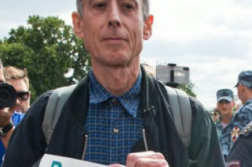MEET my new neighbor Janet. She’s of average height, has long, shapely legs, and sports a wavy mass of black hair that stops just short of her pert derrière—definitely head-turning material. She’s one in a procession of similar beauties who pass by in a steady stream. She and I exchange recipes: it turns out she is also a fantastic cook. We have become firm friends, and I wait to see if I will receive an invitation next door, but it never comes.
Baklas are effeminate men who dress in women’s garb and consider themselves in every way to be female. You may occasionally see them in other Asian countries, but their sheer numbers here, and their widespread acceptance, is what sets the Philippines apart.

Where else in the world can the gay community claim to have their own private language? The Baklas do. Developed over many years, their “gayspeak” has entered mainstream culture, and its phrases and expressions are now commonplace. “Marissa,” pronounced by dragging the last syllable out for as long as possible, is the gay Filipino version of “seriously.”
Same-sex marriage is not yet recognized in the Philippines, and LGBT people are not legally protected from discrimination. It just isn’t much of an issue here. A recent survey shows public acceptance of the LGBT community at 73 percent, and there’s little or no anti-gay discrimination.
You need to leave the city for rural Philippines to discover the origins of the bakla. A visit to a small, isolated village in Binalonan serves as a case in point. An extended family of twenty lives in three adjoining homes in a compound of sorts, typical of rural farming communities. This family counts among their numbers a gay son, a lesbian daughter, a bakla, and a bisexual son. Three out of four of the neighbor’s sons are bisexual.
The question of origins is difficult to answer, but there are a few tantalizing clues woven into the culture of the Filipinos and their casual approach to biological sex and gender. Parents in the Philippines, it seems, prefer a balance of progeny between boys and girls. A boy who’s born into a large, poor Filipino family with a lot of sons is likely to be raised in a way that restores the gender balance. Consider again my neighbor Janet, née John, who was raised by his parents to be a bakla. In a household of four sons and a mother who worked abroad, a girl was needed in the home.
Ignoring his physical sex, his parents raised him as a girl. Across the Philippines, the same story plays out in home after home.
To understand why parents might take this approach, we need to look at the family structure in the Philippines. Families are large and, especially in rural areas, under-employed. Two out of ten people in a household typically enjoy full-time employment and have to provide for the family unit. Seen in this context, a bakla can make perfect economic sense: a “daughter” who will stay at home, care for the house, cook and clean, and possibly contribute to the household income.
Of course, not every bakla is the product of family engineering; but many are. Janet was conditioned from the age of two to see herself as female. This family engineering appears to be unique to the Philippines and is not affected by a family’s religious views (most Filipinos are Catholic) or other cultural commitments. The practice offers a major opportunity for research into the efficacy of conditioning on sexual development and orientation, notwithstanding the ethical implications of this practice. One has to assume that some would-be baklas resist the transformation from an early age, but there is little documentation of this.
When it comes to sexual relations, baklas will date other baklas or bisexual men. A gay Filipino man might befriend a bakla, but the relationship rarely progresses to a sexual one. It is within their own homes that they face the most strife, as families often treat them as less worthy than other siblings. Many families feel that they were groomed to serve the household as menial servants. To the world at large, they tend to present a fun-loving and carefree face, a persona that undoubtedly contributes to the general acceptance of them.
There are no reliable surveys to indicate whether the number of baklas is on the rise, but the consensus on the street is that it is. With public acceptance of the baklas now well established, many may simply be emerging from the shadows to claim their moment in the spotlight, like Cinderella abandoning her chores to attend the costume ball.
Robert Turner, a writer and blogger who lives and works in the Philippines, is the founder of the Masaya Project, which assists rural charities.




